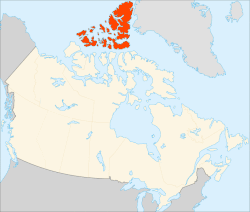Arctic wolf
| Arctic Wolf | |
|---|---|

| |
| Scientific classification | |
| Kingdom: | |
| Phylum: | |
| Class: | |
| Order: | |
| Family: | |
| Genus: | |
| Species: | |
| Subspecies: | C. l. arctos
|
| Trinomial name | |
| Canis lupus arctos Pocock, 1935
| |

| |
| Arctic Wolf ranges | |
The Arctic Wolf (Canis lupus arctos), also called Polar Wolf or White Wolf, is a mammal of the Canidae family, and a subspecies of the Gray Wolf. Arctic Wolves inhabit the Canadian Arctic and the northern parts of Greenland.
Anatomy
See also: Gray Wolf behavior and physiology
Arctic Wolves generally are smaller than Gray Wolves, being about 3 to 6 feet (0.9 to 1.8 m) long including the tail; males are larger than females. Their shoulder heights vary from 25 to 31 inches (63 to 79 cm); Arctic Wolves are bulkier than Gray Wolves, often weighing over 100 pounds (45 kg). Weights of up to 175 pounds (80 kg) have been observed in full-grown males. Arctic Wolves usually have small ears, which help the wolf maintain body heat.
Arctic Wolves have achieved life spans of over 18 years in captivity; however, in the wild, the average lifespan is only 7-10 years.
Hunting
Arctic wolves, like all wolves, hunt in packs; they mostly prey on Caribou and musk oxen, but will also kill a number of Arctic Hares, seals, ptarmigan and lemmings, as well as other smaller animals. Moose are also common prey; their long legs may render them slow and, at times, stuck, in thick snow, leaving them vulnerable to attacks by wolf packs. Due to the scarcity of grazing plants, they roam large areas to find prey up to and beyond 2600 km² (1000 square miles), and they will follow migrating caribou south during the winter. Recent footage filmed by a BBC Wildlife documentary crew shows arctic wolves hunting waterfowl.[1]
Reproduction
Normally, only the alpha male and female breed, but in large packs others may mate as well. Due to the Arctic's permafrost soil and the difficulty it poses for digging dens, Arctic Wolves often use rock outcroppings, caves or even shallow depressions as dens instead; the mother gives birth to two or three pups in late May to early June, about a month later than Gray Wolves. It is generally thought that the lower number of pups compared to the average of 4 to 5 among Gray Wolves is due to the scarcity of prey in the Arctic. They give birth in about 63 days. The wolf pups stay with their mother for 2 years.
Distribution
The Arctic Wolf is the only subspecies of the Gray Wolf that still can be found over the whole of its original range, largely because, in their natural habitat, they rarely encounter humans.

References
- L. David Mech (text), Jim Brandenburg (photos), At home with the arctic wolf, National Geographic Vol. 171 No. 5 (May 1987), pp. 562-593
- L. David Mech, The arctic wolf: 10 years with the pack, Voyageur Press 1997, ISBN 0-89658-353-8
- Template:IUCN2006
Notes
- ^ Morelle, Rebecca (2009-01-31). "Elusive wolves caught on camera". BBC. Retrieved 2008-01-31.
